When it comes to choosing a pet, the eternal debate between cats and dogs rages on. Each has its own unique qualities that can impact your relationship with them and your decision to bring a furry companion into your life. Understanding these differences is crucial in making the right choice for you. So, do you prefer cats or dogs? Let’s explore the factors that can help you decide.
Key Takeaways:
- Cats and dogs have distinct characteristics that can impact your relationship with them.
- Understanding the social nature of dogs and independent nature of cats can help you make an informed decision.
- Training, space requirements, cost considerations, and your own personality are key factors to consider.
- Compatibility with other pets, children, and your lifestyle are essential in choosing the right pet.
- Ultimately, both cats and dogs can make wonderful companions if you provide them with love and affection.
Dog’s Pack Mentality and Social Nature
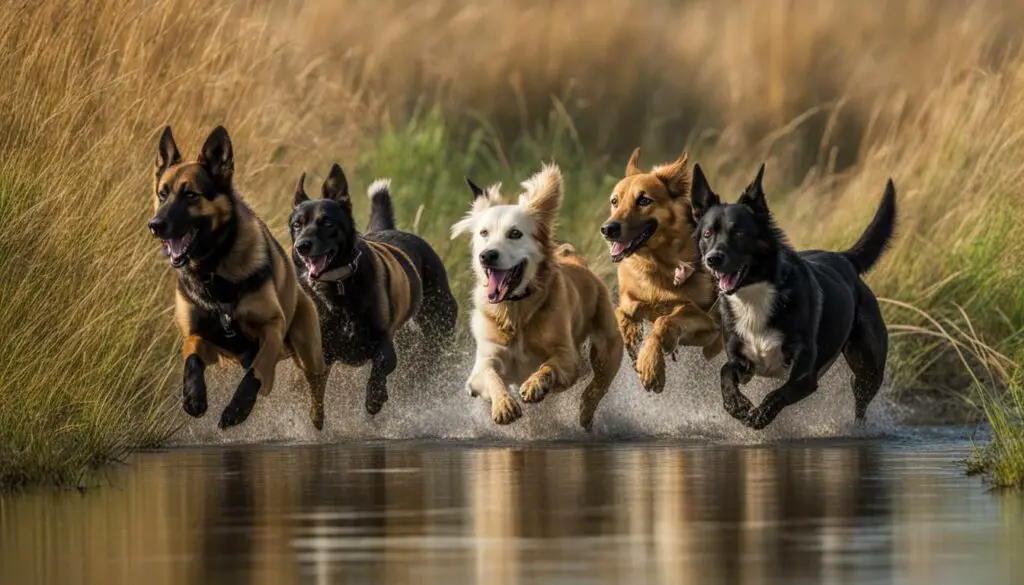
Dogs are known for their pack mentality and social nature. They have an inherent need for companionship and thrive in a social environment. In the wild, dogs form packs, which serve various purposes such as hunting, protection, and raising their young. This pack mentality is deeply ingrained in their behavior, even when they are domesticated pets.
Being social creatures, dogs seek interaction and companionship from humans or other animals. They are known for their loyalty and the strong bonds they form with their human counterparts. Dogs enjoy being part of a family and see themselves as members of a pack, with their humans as their trusted leaders.
It’s important to note that dogs require regular socialization and mental stimulation to keep them happy and well-adjusted. Frequent interaction with humans and other dogs can help prevent behavioral problems and separation anxiety. Providing opportunities for your dog to socialize, such as playdates with other dogs or visits to dog parks, can greatly contribute to their overall well-being.
Importance of Companionship for Dogs
“Dogs are highly social animals that thrive on companionship and interaction. They are happiest when they have a sense of belonging and are included in the activities of their human pack.” – Veterinary Behaviorist, Dr. Sarah Williams
Table: Benefits of Companionship for Dogs
| Benefits | Explanation |
|---|---|
| Emotional well-being | Dogs feel happier and more secure when they have companionship. |
| Reduced anxiety | Having a companion helps dogs feel less anxious when left alone. |
| Mental stimulation | Interacting with others provides mental enrichment for dogs. |
| Improved social skills | Regular socialization with humans and other dogs helps dogs develop better social skills. |
Considering dogs’ pack mentality and their need for companionship is crucial when deciding to adopt a dog. If you have the time, resources, and willingness to provide the social interaction and companionship that dogs require, they can make incredibly loving and loyal pets.
Cat’s Independent Nature and Hunting Instincts
When it comes to cats, their independent nature and hunting instincts set them apart from dogs. Unlike dogs, cats are solitary hunters in the wild, relying on their sharp claws and stealthy movements to catch prey. This hunting instinct is deeply ingrained in their behavior, leading to their independent nature.
Cats value their personal space and often prefer to sleep during the day, becoming more active and alert at night. This nocturnal behavior allows them to fulfill their natural hunting instincts in a quieter and more solitary environment. Their independent nature is also reflected in their ability to entertain themselves with toys, climbing structures, and puzzles.
However, despite their independent nature, cats can develop strong bonds with their human companions. They appreciate affection and will often seek out attention from their owners when they are in the mood. It is important to respect their need for personal space and allow them to approach and interact on their terms.
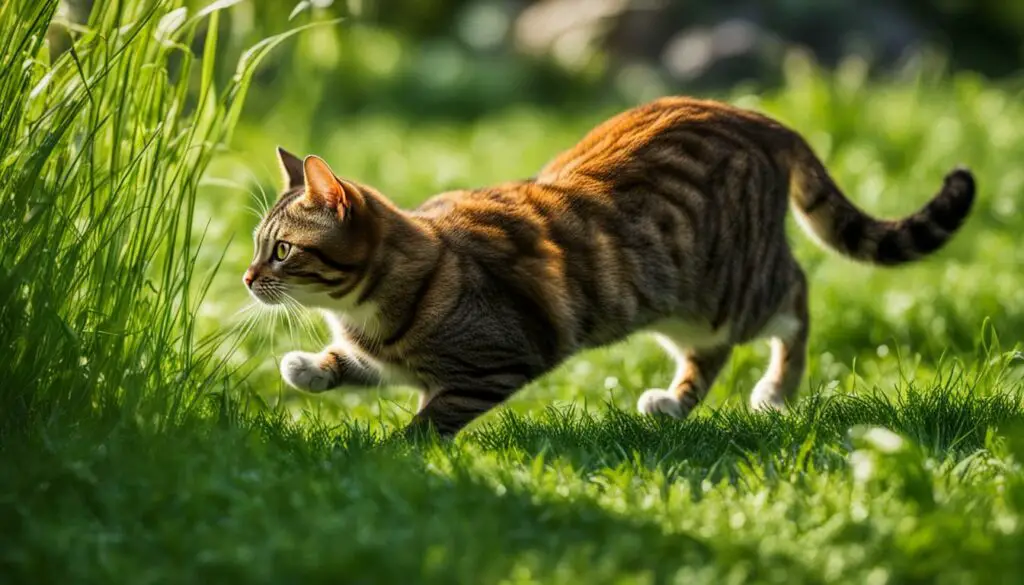
Cat’s Territoriality
In addition to their independent nature, cats are known for their territorial behavior. Cats mark their territory using various methods, including scratching, rubbing their scent glands against objects, and spraying urine. Establishing and maintaining their territory is an essential part of their survival instinct and plays a role in their overall well-being.
As a result, cats may show aggression towards unfamiliar animals or intruders in their territory. They may also exhibit territorial behavior within their home, such as guarding certain areas or objects. Providing them with designated spaces, such as scratching posts and hiding spots, can help satisfy their territorial needs and reduce anxiety.
| Cats | Dogs | |
|---|---|---|
| Independence | High | Low |
| Socialization | Selective | High |
| Exercise Needs | Low | High |
| Training Difficulty | Medium | Low |
Table: Comparison of Cat and Dog Traits
Training Differences: Dogs vs Cats
When it comes to training, dogs and cats have distinct differences. Dogs are known for their obedience and eagerness to please their human companions. Cats, on the other hand, have a more willful nature and may require a different approach when it comes to training.
Dogs are pack animals by nature and have a strong desire to please their owners. This inherent trait makes them more receptive to training and eager to follow commands. They thrive on positive reinforcement and are quick to learn new tricks and behaviors.
Cats, on the other hand, are more independent creatures. They have a strong sense of self and may not be as motivated by the desire to please their owners. Training a cat requires patience, consistency, and a focus on positive reinforcement. It may take more time and effort to see results, but with the right approach, cats can be trained to follow certain commands and behaviors.
Training Differences: Dogs vs Cats
Table: Training Differences: Dogs vs Cats
| Training Aspect | Dogs | Cats |
|---|---|---|
| Obedience | High | Variable |
| Motivation | Eager to please | Self-motivated |
| Learning Speed | Quick | Variable |
| Training Approach | Positive reinforcement | Patience and consistency |
As the table above shows, dogs tend to excel in obedience, motivation, and quick learning. Cats, on the other hand, have a more variable response to training and require a patient and consistent approach. This doesn’t mean that cats are impossible to train, but rather that their training may require more time and effort.
In conclusion, when it comes to training, dogs have a natural inclination towards obedience and are more easily trainable. Cats, on the other hand, have a more independent and willful nature, requiring a different training approach. Understanding these training differences can help pet owners set realistic expectations and develop effective training strategies for their furry friends.
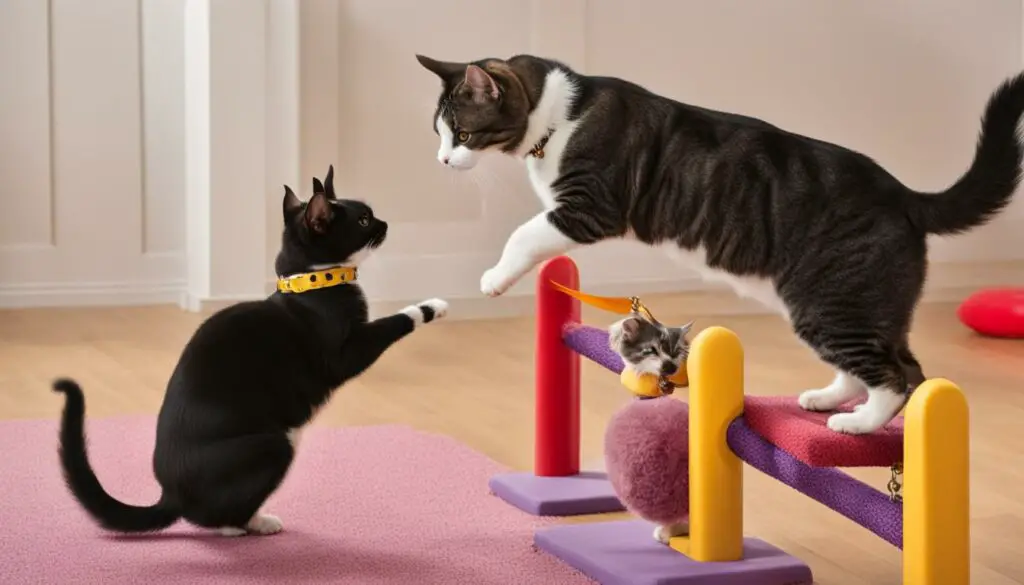
Consider Space: Dogs and Cats
When deciding between getting a dog or a cat, it’s important to consider the available space in your living environment. Dogs generally require more space, particularly outdoor space, to meet their exercise needs. If you live in a small apartment, it’s crucial to ensure that you can provide enough outdoor time and exercise for a dog to thrive.
On the other hand, cats are more adaptable to small living spaces and can comfortably live indoors. They don’t require as much outdoor space and exercise as dogs do. As long as they have access to a litter box, toys, and scratching posts, cats can be content and happy indoors.
To help understand the space requirements better, let’s take a look at the table below:
| Dogs | Cats | |
|---|---|---|
| Outdoor Space | Require regular outdoor exercise | Adaptable to limited outdoor space |
| Indoor Space | Smaller living spaces may not be ideal | Comfortable living indoors |
| Exercise Needs | Require more exercise and outdoor activities | Less exercise needed, independent nature |
As you can see, dogs generally have a greater need for outdoor space and exercise compared to cats. However, it’s important to note that individual pet temperaments can vary, and some dogs may adapt better to small living spaces than others. It’s always recommended to consider the specific breed and their exercise requirements when making a decision.
Cost Considerations: Dogs and Cats
When deciding to bring a furry friend into your home, it’s essential to consider the financial commitment required. Both dogs and cats come with their own set of costs, including food, veterinary care, grooming, and supplies. However, the cost of owning a dog tends to be higher compared to owning a cat.
Table: Cost Breakdown
| Expense Category | Dog | Cat |
|---|---|---|
| Food | Varies based on breed size and dietary needs | Lower cost compared to dogs |
| Veterinary Care | Essential vaccinations, preventive medications, and potential surgeries | Essential vaccinations and preventive medications |
| Grooming | Regular grooming, including bathing and professional grooming services | Minimal grooming required |
| Supplies | Leashes, collars, toys, bedding, and training aids | Litter box, litter, toys, scratching posts, and grooming tools |
As shown in the table above, dog ownership typically involves higher costs across multiple categories. Dogs generally require more food due to their larger size and higher energy levels. Veterinary care for dogs is often more expensive, as they may require additional vaccinations and preventive medications. Grooming costs can vary based on the breed and coat type, with dogs typically needing more grooming than cats. Additionally, dog supplies such as leashes, collars, and training aids can add up over time.
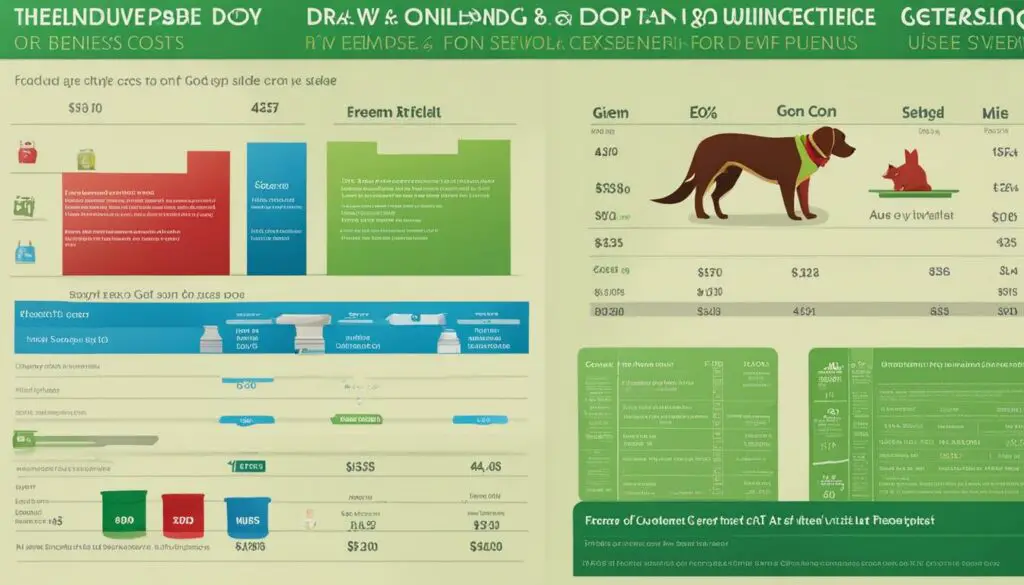
On the other hand, owning a cat tends to be more cost-effective. Cats require less food compared to dogs, and veterinary care costs are generally lower as well. Grooming needs for cats are minimal, as they are capable of self-grooming. Cat supplies, such as litter boxes, litter, toys, and scratching posts, also tend to be more affordable.
When considering a pet, it’s important to evaluate your budget and determine what level of expenditure you are comfortable with. While dogs may have higher initial and ongoing costs, the love and companionship they provide can make it a worthwhile investment. Cats, with their lower upkeep costs, can be a more budget-friendly option without compromising on the joy they bring to your home.
Personality Differences: Cat People vs Dog People
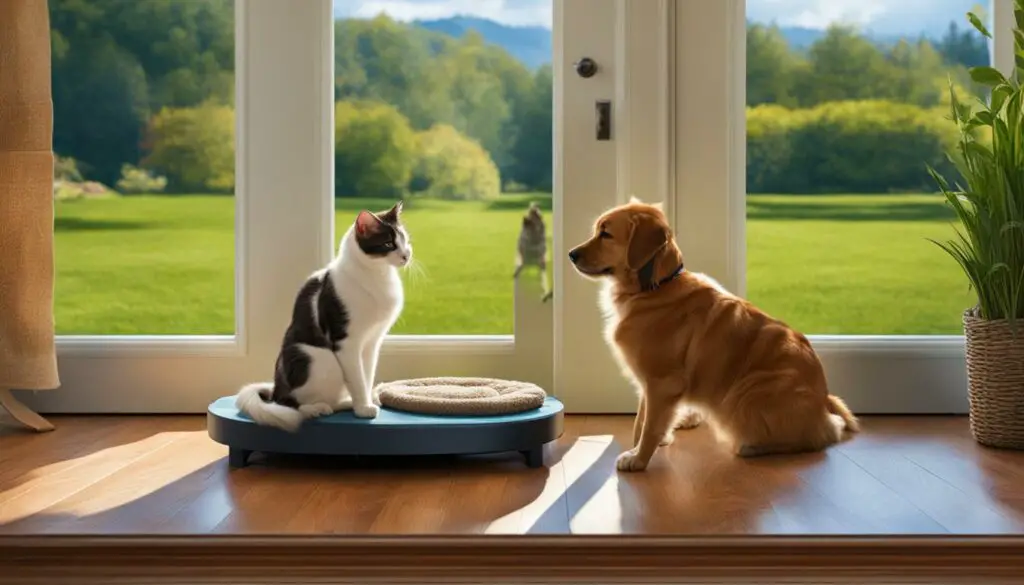
When it comes to pet preferences, there are often distinct personality differences between cat people and dog people. These differences can influence the type of companion someone chooses to bring into their life. Cat lovers tend to be more introverted, enjoying solitude and quiet moments. They appreciate the independence and low-maintenance nature of cats. On the other hand, dog lovers are often more extroverted, enjoying social interactions and active lifestyles. They value the companionship and loyalty that dogs bring.
Cat people are known for their self-contained nature and independence, which aligns with the independent nature of cats. They enjoy the calm and peaceful environment that cats create. Dog people, on the other hand, thrive on social interactions and enjoy the energetic nature of dogs. They find joy in the active companionship that dogs provide.
“I’ve always been more of a cat person. I appreciate their laid-back nature and how they can entertain themselves. They’re perfect for my introverted personality.” – Cat Lover
“I’ve always been a dog person. I love their enthusiasm and the way they bring so much energy into my life. They’re the perfect companion for my active lifestyle.” – Dog Lover
Cat People vs Dog People: A Personality Comparison
| Personality Traits | Cat People | Dog People |
|---|---|---|
| Introversion vs Extroversion | Prefer solitude and quiet moments | Enjoy social interactions and active lifestyles |
| Independence vs Companionship | Appreciate the independence and low-maintenance nature of cats | Value the companionship and loyalty that dogs bring |
| Quiet vs Energetic | Enjoy the calm and peaceful environment created by cats | Find joy in the active companionship that dogs provide |
Understanding these personality differences can help individuals choose the pet that aligns best with their own temperament and lifestyle. Whether someone identifies as a cat person or a dog person, both cats and dogs can bring love and companionship into their lives. Ultimately, the decision should be based on personal preference and the ability to meet the needs of the chosen pet.
Pet Suitability for Apartment Living, Active Lifestyle, and Busy Individuals
If you live in an apartment or have a busy lifestyle, it’s essential to consider your pet’s suitability to ensure they thrive in their environment. Apartment living requires pets that can adapt to smaller spaces and potentially limited outdoor access. Individuals with active lifestyles may benefit from a pet that can keep up with their energy levels. Busy individuals, on the other hand, may need a pet that can entertain themselves and require minimal supervision.
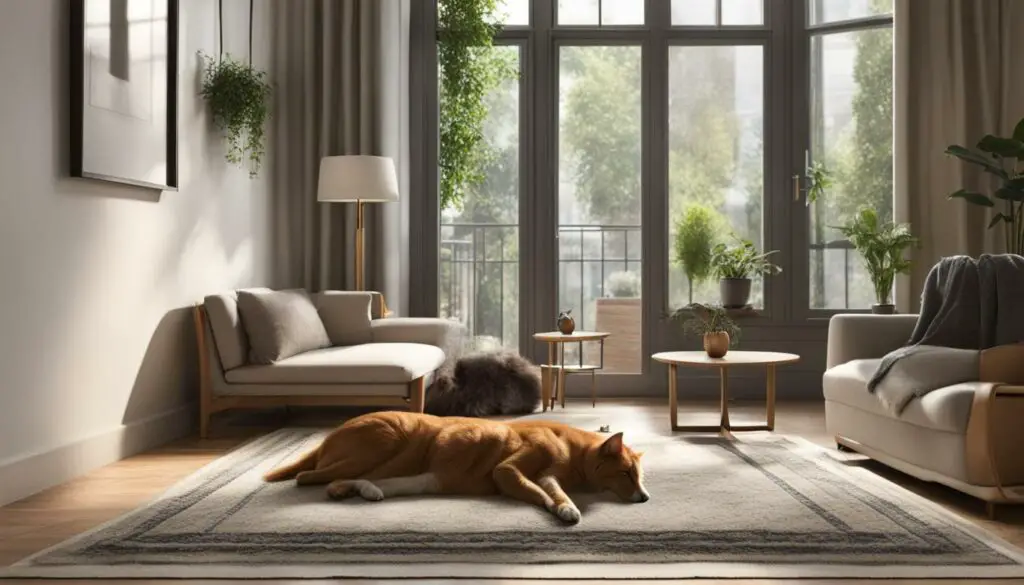
For apartment living, cats are generally more suitable due to their independence and adaptability to smaller spaces. They don’t require regular outdoor exercise, so they can be content and happy indoors as long as they have access to a litter box, toys, and scratching posts. Cats are also more self-sufficient and can entertain themselves while their owners are away.
However, if you lead an active lifestyle and enjoy outdoor activities, a dog may be the better choice for you. Dogs thrive in environments where they can get regular exercise and social interaction. They enjoy accompanying their owners on walks, runs, and adventures. Having a dog can be a great motivator to stay active and explore the outdoors.
For busy individuals who may not have the time to devote to constant supervision and interaction, cats are often a better fit. Cats are independent by nature and can entertain themselves with toys, scratching posts, and other environmental enrichment. They don’t require the same level of attention and activity as dogs and can be content in their own company.
Considering the Size of a Pet
When choosing a furry friend to welcome into your home, considering the size of the pet is an important factor. Different breeds of dogs and cats vary greatly in size, and finding a pet that fits well with your lifestyle and living space is essential.
Large Dog Breeds
If you have ample outdoor space and are looking for a companion for outdoor activities, a large dog breed may be the perfect choice. Breeds such as the Labrador Retriever, German Shepherd, and Golden Retriever are known for their size and strength. These dogs require regular exercise and room to roam.
Large dogs can be great for families with children, as they often have a gentle and patient nature. However, it’s important to consider the size and strength of these breeds when living in a smaller space or having young children, as they may unintentionally knock over furniture or unintentionally knock over children during play.
Small Dog Breeds
If you have limited space or live in an apartment, a smaller dog breed may be more suitable. Breeds such as the Chihuahua, Yorkshire Terrier, and Shih Tzu are known for their small size and adaptability to indoor living. These dogs require less exercise and are generally easier to manage in smaller spaces.
Small dogs can be ideal companions for individuals or families with limited outdoor access. They can provide the same love and loyalty as larger breeds, but in a more compact and manageable size.
The Size of Cats
Cats, in general, are smaller in size compared to most dog breeds. They are more adaptable to indoor living and can comfortably thrive in smaller spaces like apartments. With various breeds available, you can choose a cat that suits your preferences, whether that’s a large breed like the Maine Coon or a smaller breed like the Siamese.
Cats are known for their agility, independence, and ability to entertain themselves. They require less physical exercise compared to dogs but still need adequate space to climb, play, and explore. Providing cat trees, scratching posts, and interactive toys can help meet their needs.
Table: Size Comparison of Dog Breeds and Cats
| Breed | Average Weight (lbs) | Average Height (inches) |
|---|---|---|
| Labrador Retriever (Dog) | 55-80 | 21.5-24.5 |
| Chihuahua (Dog) | 2-6 | 5-8 |
| Maine Coon (Cat) | 11-25 | 10-16 |
| Siamese (Cat) | 8-10 | 8-10 |
Remember, the size of the pet is just one factor to consider when making your decision. It’s also essential to evaluate your lifestyle, living situation, and personal preferences to ensure that you choose a pet that will be a perfect fit for you and your family.
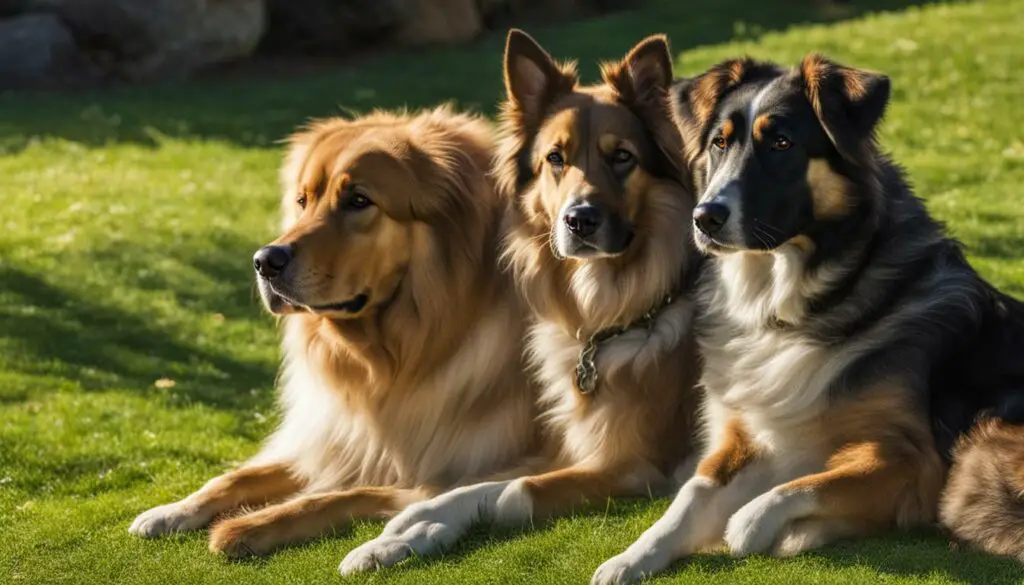
Your Personality and Pet Preference
| Pet Preference | Cat | Dog |
|---|---|---|
| Easygoing Nature | ✅ | ❌ |
| Active Companionship | ❌ | ✅ |
| Pet Compatibility with Other Pets | ❌ | ✅ |
If you prefer a more easygoing and independent pet, a cat may be a good fit. Cats are known for their easygoing nature and can adapt well to different environments. They are generally low-maintenance and don’t require constant attention. Cats can provide great companionship without the need for vigorous exercise or constant playtime. Their calm and laid-back demeanor makes them suitable for individuals who prefer a more relaxed lifestyle.
On the other hand, if you’re looking for an active companion who will join you on outdoor adventures, a dog might be the better choice. Dogs thrive on active companionship and enjoy regular exercise. They are always ready for a walk, hike, or game of fetch. Dogs provide a sense of adventure and can be great motivators for maintaining an active lifestyle. Their energetic and lively nature makes them perfect for individuals who enjoy more interaction and physical activities.
When considering pet compatibility with other animals, dogs tend to be more social and adaptable. They can often get along well with other pets, such as cats or smaller animals, when properly introduced and trained. Cats, on the other hand, can be more territorial and may not always be accepting of other pets in their space. If you already have other pets at home, it’s important to consider their compatibility with a new addition. Proper introductions and gradual integration can help ensure a harmonious environment for all pets involved.

Understanding Your Preferences
Ultimately, the choice between a cat and a dog depends on your personality, lifestyle, and preferences. Consider your own temperament and the type of relationship you envision with a pet. If you prefer a more independent and easygoing companion, a cat may be the perfect fit. If you’re seeking an active and devoted companion who will join you in various activities, a dog might be the ideal choice.
It’s essential to evaluate your own needs and expectations when deciding on a pet. Take into account factors such as space, time availability, financial considerations, and compatibility with existing pets or family members. Both cats and dogs can bring joy, love, and companionship into your life, but it’s important to choose the right pet that aligns with your personality and lifestyle.
Pets Suitable for Younger Children
When considering a furry friend for your younger children, it’s important to choose a pet that is known to be good with kids and can handle their energy levels. Some pets are naturally more patient and tolerant, making them ideal companions for children. Here are a few options to consider:
- Dogs: Certain dog breeds are known for their friendly and gentle nature around children. Breeds such as Golden Retrievers, Labrador Retrievers, and Beagles are often recommended for families with young children. These dogs are typically patient, playful, and adaptable to the energy levels of kids. Always supervise interactions between dogs and young children to ensure safety.
- Cats: Cats can also be great companions for younger children. Many cats are tolerant of children and can form strong bonds with them. When choosing a cat, look for breeds known for being good with kids, such as Ragdolls, Maine Coons, or Persians. It’s important to teach young children how to handle cats gently and with respect to avoid any accidental scratching or rough play.
- Small Animals: If you’re looking for a smaller pet, consider options like rabbits, guinea pigs, or hamsters. These animals can be great for teaching children about responsibility and caring for a pet. However, it’s important to note that small animals may require more supervision when interacting with younger children due to their delicate nature.
Remember, regardless of the type of pet you choose, it’s crucial to teach your children how to interact with animals safely and respectfully. Supervision is key, particularly with young children, to ensure the well-being of both the child and the pet.
Here’s a table summarizing some of the best pet options for younger children:
| Pet | Recommended Breeds | Temperament |
|---|---|---|
| Dogs | Golden Retrievers, Labrador Retrievers, Beagles | Patient, playful, adaptable |
| Cats | Ragdolls, Maine Coons, Persians | Tolerant, affectionate, bonding |
| Small Animals | Rabbits, Guinea Pigs, Hamsters | Interactive, educational |
Choosing the right pet for your younger children involves considering their safety, compatibility, and the ability to handle the pet’s needs. By selecting a pet that is known to be good with kids and providing proper supervision and guidance, you can create a loving and enriching environment for both your children and their furry friend.

Cat and Dog Interaction: Can They Coexist?
One common question for potential pet owners is whether cats and dogs can live together harmoniously. The answer is, it depends. While some cats and dogs form close bonds and become best friends, others may not tolerate each other’s presence. Understanding the nature of your current pets and taking the necessary steps to ensure a smooth introduction can increase the chances of successful coexistence.
Introducing a Dog to a Cat
When introducing a dog to a cat, it’s important to proceed with caution and take gradual steps. Start by allowing the pets to become familiar with each other’s scents. This can be done by exchanging bedding or rubbing a towel on each animal and then allowing them to smell it. Progress to visual introductions by using a baby gate or a pet barrier, allowing them to see each other without direct physical contact. Finally, under close supervision, you can introduce the dog and cat in the same space, ensuring that both animals have an escape route if needed.
It’s crucial to remain patient during the introduction process, as it can take time for cats and dogs to adjust to each other’s presence. Reward positive behavior with treats and praise, while also providing each pet with their own designated spaces and resources to prevent any potential conflicts.
Introducing a Cat to a Dog
Introducing a cat to a dog follows a similar process, with a focus on gradual introductions. Start by setting up a safe room for the cat, equipped with food, water, a litter box, toys, and a comfortable resting area. Allow the cat to become familiar with their new surroundings before introducing them to the dog.
When introducing the cat and dog, it’s important to keep the dog on a leash initially to ensure control. Allow them to see each other from a distance and gauge their reactions. Over time, you can gradually increase their proximity, always prioritizing the safety and well-being of both pets. Monitor their interactions closely, and if any signs of aggression or stress occur, separate them and consult a professional trainer or behaviorist for guidance.

Creating a Peaceful Environment
To increase the chances of successful coexistence between cats and dogs, it’s essential to create a peaceful and harmonious environment for both pets. Provide each animal with their own space, including separate sleeping areas, feeding stations, and litter boxes for cats. This allows them to have their own territory and reduces the likelihood of conflicts.
Additionally, ensure that both pets receive ample mental and physical stimulation. Play with your dog regularly, engage them in training exercises, and take them for walks to burn off excess energy. For cats, provide interactive toys, scratching posts, and vertical spaces for climbing and perching.
| Dogs | Cats | |
|---|---|---|
| Exercise Needs | Require daily exercise and outdoor activities. | Need less exercise and can be content indoors. |
| Socialization | Highly social and thrive in a pack environment. | Independent by nature and value personal space. |
| Training | Easier to train due to their eagerness to please. | Can be trained with patience and consistent practice. |
| Compatibility | Dependent on individual personalities and circumstances. | Dependent on individual personalities and circumstances. |
In conclusion, while cats and dogs can coexist, it’s important to consider the individual personalities and needs of each animal. With proper introductions, patience, and a peaceful environment, many cats and dogs can live together harmoniously and even form strong bonds. However, it’s crucial to monitor their interactions and ensure the safety and well-being of both pets throughout the process.
Conclusion
When it comes to choosing between cats and dogs, making the right pet choice is a personal decision that depends on your lifestyle, preferences, and compatibility. Both cats and dogs have their unique qualities and can make wonderful companions if given the love and affection they deserve.
Consider factors such as space, cost, training, and personality traits when making your decision. If you live in an apartment and prefer a more independent pet, a cat may be a suitable choice. Dogs, on the other hand, are great for those with an active lifestyle and who enjoy outdoor activities.
Remember to think about the size of the pet you prefer, as well as the age of your children if you have any. Some pets are more compatible with younger children and can handle their energy levels better than others. Supervision is crucial when introducing pets to younger children.
Lastly, if you already have a pet at home, consider their nature and compatibility when deciding between a cat and a dog. While dogs and cats can coexist in the same household, their compatibility varies. Some may get along well, while others may not tolerate each other’s presence.
FAQ
Do cats or dogs need more social interaction?
Dogs are social animals and require more companionship compared to most cats. They thrive in a family environment where they can be part of a pack.
Are cats more independent than dogs?
Yes, cats are generally more independent by nature. They are solitary hunters in the wild and value their personal space.
Can cats be trained like dogs?
While cats can be trained, it requires patience and consistent practice. Positive reinforcement and setting boundaries are key when training cats.
Can dogs adapt to living in apartments?
Dogs can adapt to living in small apartments if they receive regular outdoor exercise. They need regular physical activity to stay happy and healthy.
Are cats suitable for apartment living?
Yes, cats are more adaptable to apartment living as they don’t require as much space and exercise. As long as they have proper enrichment and a litter box, they can be content indoors.
Are dogs more expensive to care for compared to cats?
Yes, dogs tend to be more expensive to care for. They require factors like food, toys, training classes, and vet bills. Cats are generally more self-sufficient and rely mainly on their owners for food.
Do cat people have different personality traits compared to dog people?
Yes, cat people are often introverted, less sociable, and self-contained, while dog people are more social, interactive, and open to new experiences.
Are cats or dogs suitable for busy individuals?
Cats are more independent and can entertain themselves, making them suitable for busy individuals. Dogs require more attention and interaction.
Do cats and dogs get along?
The compatibility between cats and dogs varies. Some may get along well, while others may not tolerate each other. It depends on the nature and personalities of the individual pets.
How do I choose between a cat and a dog?
The decision ultimately depends on your lifestyle, preferences, and compatibility. Consider factors such as space, cost, training, and personality traits to make an informed choice.
What pets are suitable for younger children?
Some breeds of dogs and cats are known to be good with kids and can handle their energy levels. However, supervision is crucial when introducing pets to younger children.
Can cats and dogs live together?
Cats and dogs can coexist in the same household, but their compatibility varies. Some may get along well, while others may not tolerate each other’s presence.
What should I consider when choosing between cats and dogs?
Consider your lifestyle, space, cost, training requirements, and compatibility with existing pets when making your choice. Both cats and dogs can make wonderful companions with enough love and affection.
Source Links
- https://www.hillspet.com/pet-care/new-pet-parent/choosing-between-dogs-and-cats
- https://midlandspetcare.com/should-we-get-a-dog-or-a-cat/
- https://www.purina.co.uk/find-a-pet/articles/getting-a-cat/adoption/adopt-dog-or-cat





